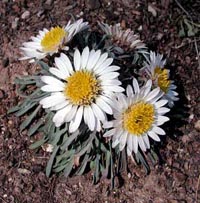Resource Library
Plant of the Week: Easter Daisy
The University of Arkansas System Division of Agriculture does not promote, support or recommend plants featured in "Plant of the Week." Please consult your local Extension office for plants suitable for your region.
Plant of the Week
Easter Daisy
Latin: Townsendia exscapa

To me at least, plants and plant lore are an endless source of fascination.
By naming plants after significant - and sometimes not so significant - people, botanists have provided a delightful means of keeping the past alive. I was reminded of this association as I perused the tiny typeface of the North American Rock Garden Seed list and came across a listing for a dozen species of Townsendia.
Few Arkansas gardeners have reason to know the Easter Daisy, Townsendia exscapa, for it grows in the dry prairies east of the Rockies from Manitoba to New Mexico. And it’s a little plant, seldom over three inches tall. Its diminutive size makes it a favorite amongst rock gardeners who have a hangup on little plants.
What makes the Easter daisy so cute is the fact that, for such a runt of a plant, it has typical daisy blooms that are almost as wide as the plant is tall. In the spring, a cushion of these white, 2-inch wide flowers with yellow centers cover the crown of the plant. The species epitaph translates as "without a scape," meaning the flowers are crowded right in the foliage of the plant.
In their native habitat, Townsendias, of which there are about 20 species, are mostly short-lived perennials or biennials.
I first learned of their namesake, John Kirk Townsend (1809 - 1851), as a young man when I read his delightful travelogue, Narrative of a Journey Across the Rocky Mountains to the Columbia River, which he published in 1839 following his 1834 expedition across the continent. Still in his 20s, Townsend was wide-eyed and excited about the opportunity of visiting the American West when it was still mostly blank space on the map.
Townsend traveled with the Wyeth trading expedition that opened an overland route to the West that later became known as the Oregon Trail. With the expedition was another scientific luminary of his day, Thomas Nuttall, who was employed by Harvard University to manage their fledgling botanic garden.
Nuttall invited Townsend to make the trip and probably helped him arrange a $250 subscription from the Philadelphia Academy of Natural Sciences and the American Philosophical Society. With Nuttall covering the plants, Townsend was to collect fauna, especially birds that had become his specialty.
Townsend’s fame amongst ornithologists was solidified when John Audubon, a friend of the family, included some of his birds in the last volume of his famous folio. Townsend is a great story teller and relates such tail happenings as his traveling companions roasting and eating an owl he was going to stuff and, on another occasion, of the cook straining the lizards he has floating in a bottle of alcohol off so he could partake of the liquor.
In addition to the plants named in his honor, Townsend is also remembered by the Townsend bunting and a mole named in his honor. Townsend died as a relatively young man because of his passion for birding. To protect his stuffed specimens he developed a concoction to ward off vermin that might attack the specimens. This mix contained arsenic as a key ingredient. He died of chronic arsenic poisoning at age 42.
Germinating Easter daisies is not especially difficult, but keeping the seedlings alive is a bit trickier. They are from the high and dry middle region of the country, so promptly die if they get too wet. They need to be grown in a sunny location in a well drained, gritty soil that bakes during the summer. Other than seed exchanges and from wildflower seed collectors, seed is seldom offered.
By: Gerald Klingaman, retired
Extension Horticulturist - Ornamentals
Extension News - January 28, 2005
The University of Arkansas System Division of Agriculture does not maintain lists of retail outlets where these plants can be purchased. Please check your local nursery or other retail outlets to ask about the availability of these plants for your growing area.